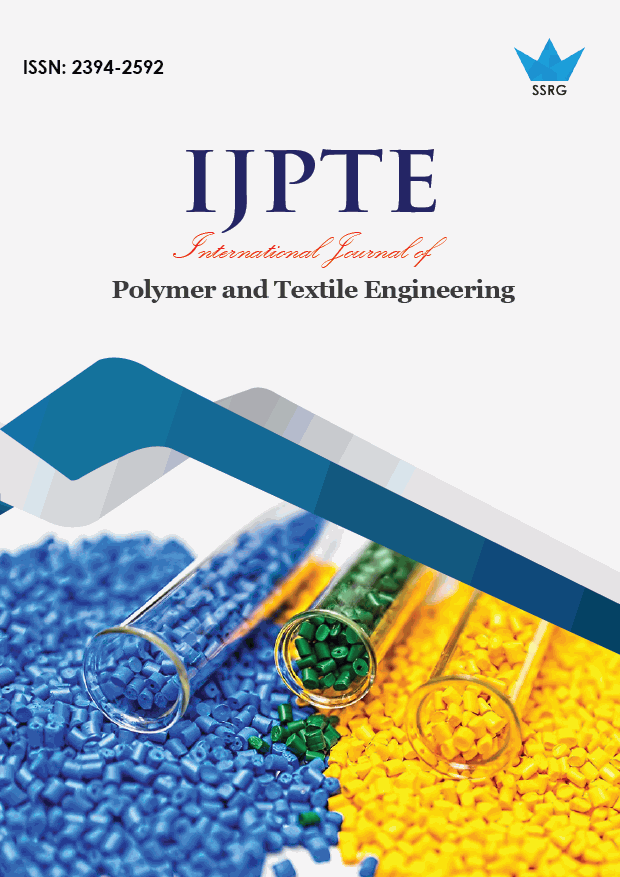Effect of Time on Dyeing Cotton Knitted Fabrics with Reactive Dyes

| International Journal of Polymer and Textile Engineering |
| © 2017 by SSRG - IJPTE Journal |
| Volume 4 Issue 1 |
| Year of Publication : 2017 |
| Authors : Subrata Chandra Das, Debasree Paul, Md. Abu Bakar Siddiquee, Md. Abdullah Al Mamun |
How to Cite?
Subrata Chandra Das, Debasree Paul, Md. Abu Bakar Siddiquee, Md. Abdullah Al Mamun, "Effect of Time on Dyeing Cotton Knitted Fabrics with Reactive Dyes," SSRG International Journal of Polymer and Textile Engineering, vol. 4, no. 1, pp. 8-11, 2017. Crossref, https://doi.org/10.14445/23942592/IJPTE-V4I1P102
Abstract:
The effect of dyeing time has been studied on the color strength and color fastness properties of single jersey cotton knitted fabrics dyed with Novacron Red S-B reactive dye (1%) using conventional exhaust dyeing method. Same bath scouring and bleaching are done and conventional exhaust dyeing method employed by IR laboratory sample dyeing machine. Various dyeing time such as 40, 60 and 80 minutes are used and other parameters are kept fixed. The color strength (K/S) and color fastness to wash and rubbing are examined and evaluated. It is observed that the increase in dyeing time from 40 minutes to60 minutes the value of K/S increases and then up to80 minutes the value decreases.The overall color fastness properties to washing and rubbing for the dyed samples range from good to excellent.
Keywords:
Dyeing time, cotton fabrics, reactive dye, color strength, color fastness.
References:
[1] S. P. Mishra, A Text Book of Fibre Science and Technology, New Age International (P) Limited, Publishers, New Delhi, India, 2000.
[2] https://en.wikipedia.org/wiki/cotton (access date: 03/10/2017).
[3] E.P.G. Gohl and L.D. Vilensky, Textile Science, 2nd ed., CBS Publishers & Distributors, Delhi, India, 1983.
[4] N. S. Kaplan, Textile Fibres, Abhishek Publications, Chandigarh, India, pp. 1-39, 2008.
[5] E. R. Trotman, Dyeing and Chemical Technology of Textile Fibres, 6th ed., John Wiley & Sons Inc., March 21, 1985.
[6] K. Y. Tam, E. R. Smith, J. Booth, R. G. Compton,C. M. Brennan, and J. H. Atherton,“Kinetics and mechanism of dyeing processes: the dyeing of cotton fabrics with a procion blue dichlorotriazinyl reactive dye”, J. Colloid Interface Sci.,vol. 186, pp. 387-398, 1997.
[7] D. M. Lewis, and L. T. T.Vo,“Dyeing cotton with reactive dyes under neutral conditions”, Color. Technol.,vol. 123, pp. 306-311, 2007.
[8] A. D. Broadbent, Basic Principles of Textile Coloration, Society of Dyers and Colourists, Bradford, England, 2001.
[9] L. Fang, X. Zhang, andD. Sun,“Chemical modification of cotton fabrics for improving utilization of reactive dyes”,Carbohydrate Polymers, vol. 91, no. 1, pp. 363–369, 2013. Doi: https://doi.org/10.1016/j.carbpol.2012.08.049.
[10] D. Paul, S. C. Das, T. Islam, M. A. B. Siddiquee and M. A. A. Mamun, “Effect of alkali concentration on dyeing cotton knitted fabrics with reactive dyes”, Journal of Chemistry and Chemical Engineering, vol. 11, no. 4, 2017.
[11] M.S. Alam, G.M.A. Khan, S.M.A. Razzaque, M.J. Hossain, M. M. Haque, and S. Zebsyn, “Dyeing of cotton fabrics with reactive dyes and their physico-chemical properties”, Indian Journal of Fibre and Textile Research, vol. 33, pp. 58-65, 2008.
[12] A. D. Broadbent, J. Bissou-Billong, M. Lhachimi, Y. Mir, and S.Capistran, “Continuous dyeing of cotton with reactive dyes using infrared heat”, Ind. Eng. Chem. Res., vol. 44, pp. 3954-3958, 2005.
[13] A. Khatri, M. H. Peerzada, M.Mohsin, M. White, “A review on developments in dyeing cotton fabrics with reactive dyes for reducing effluent pollution”, Journal of Cleaner Production, 2014. Doi: http://dx.doi.org/10.1016/j.jclepro.2014.09.017.
[14] D. Das, S.Bakshi, and P. Bhattacharya,“Dyeing of sericin-modified cotton with reactive dyes”, The Journal of The Textile Institute, vol. 105, no. 3, pp. 314-320, 2014.Doi: 10.1080/00405000.2013.839353.
[15] M. Iftikhar, N. A. Jamil,and B.Shahbaz, “Rubbing, ironing and dry cleaning fastness of reactive dyed cotton knitted fabric as influenced by salt, alkali and dye”, International Journal of Agriculture & Biology, vol. 3, no. 1, pp. 109-112, 2001.
[16] R. S. Blackburn, S. M.Burkinshaw, and G.W. Collins, “The application of cationic fixing agents to cottondyed with direct dyes under different pH conditions”, TSDC, vol. 114, pp.317-320, 1998.
[17] N. D. Tissera, R. N. Wijesena, K. M. Nalin de Silva, “Ultrasound energy to accelerate dye uptake and dye–fiber interaction of reactive dye on knitted cotton fabric at low temperatures”, UltrasonicsSonochemistry,2015.Doi: http://dx.doi.org/10.1016/j.ultsonch.2015.10.002.
[18] R. Mcdonald,Color Physics for Industry, 2nd ed., Society of Dyers and Colourist, Bradford, UK, 1997.

 10.14445/23942592/IJPTE-V4I1P102
10.14445/23942592/IJPTE-V4I1P102